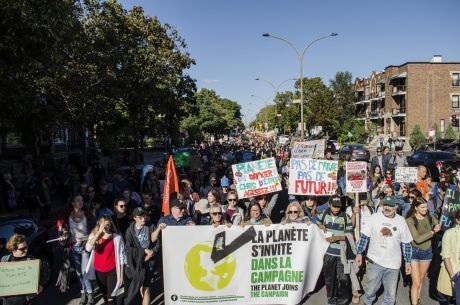Features
You are here
Climate action: governments stall while the people rise up

January 6, 2019
In a tragic recreation of Nero fiddling while Rome burns, we see our governments using carbon taxation as the panacea for climate chaos while the Intergovernmental Panel on Climate Change points to the need for far more drastic legislation to transition away from the use of fossil fuels within twelve years. Staying at or below a 1.5°C temperature increase requires slashing global greenhouse gas emissions 45 percent below 2010 levels by 2030 and reaching net zero by 2050. Going from the west to the east across Canada and Quebec allows you to see both political failure as well as the power of numbers on the street.
BC NDP not listening to First Nations, cities
In BC, the NDP, relying on the Green Party for support, began its time in office by needlessly approving the Site C dam, against tremendous popular opposition. And while they might want to lay claim to part of the victory around the halt to the TransMountain pipeline (even though the heavy lifting in court was done by First Nations, municipal and environmental groups), they have shown their true blue colours with their enthusiastic support for the LNG Canada project, including TransCanada’s Coastal GasLink pipeline. As reported previously on Socialist.ca, the Unist’ot’en Camp in northern BC is at the front line of stopping this project from going ahead and every ounce of our solidarity needs to be going to these indigenous land protectors. Join solidarity rallies across Turtle Island on Tuesday January 8.
The BC NDP climate plan announced in December has a goal to cut greenhouse gas emissions by 40 per cent by 2030, 60 per cent by 2040 and 80 per cent by 2050, which is far too little, far too late, and mainly to be achieved in the building and transportation sectors. But the carbon impact of the LNG completely undermines whatever gains to be made through the building and transportation changes.
Alberta NDP: earning a special place in hell
NDP Premier Notley in Alberta has never met a pipeline she didn’t love, which means the ongoing expansion of the tar sands, the filthiest oil on the planet. She has also been peddling a story of huge economic loss to the Canadian economy, to the tune of $80 million per day in lost oil revenues, due to lack of transmission capacity by both rail and pipeline. The same figure is used repeatedly in the mainstream media and by other provincial and federal politicians. But economist Robyn Allan, writing for the National Observer on November 26, 2018, points out that Notley and the others rely on a flawed report by Scotiabank that incorrectly calculated the volume of oil subject to the higher than average price differential between Alberta’s heavy crude and the lighter Texas oil. “Anyone who understands the buying and selling of Canada’s crude knows most barrels are protected from spot market pricing because major companies have spent years implementing business strategies to do so.” Allan estimates only 20% of Alberta’s oil is affected by the “spot market” differential. Meanwhile Notley, Trudeau and the media use the $80 million figure to scare workers.
In a more dangerous cover-up, what Notley and previous Alberta governments have not accounted for is the recently published $260 billion liability to clean up the oil patch, hundreds of billions more than industry or governments have publicly been letting on. The costs are for shutting down disused wells and pipelines and cleaning up toxic tailings ponds that store the waste from the mining of bitumen. The government has only collected $1.6 billion in liability security from the companies.
Meanwhile in mid-December the federal government said it would provide $1.6 billion in financial support to help Alberta's oil and gas sector expand into new markets. International Trade Diversification Minister Jim Carr described how the money will be used to help the oil patch in part with liquidity concerns. "Alberta's energy sector is not just the historic backbone of our economy, but a key part of our country's future. The workers in this sector are valued parts of our national economy." The trouble is, the workers won’t be seeing any of this money.
Also in December Notley announced she was imposing an oil production cut to drain out excess oil being stored in the province as the bottleneck restricts shipments. She has also floated a plan to buy more rail cars to ship more oil. “I hate to break it to you, but the whole world wants our product. The issue is not finding a market for our product. The issue is getting our product to that market,” Notley said. Sorry but not only does “the whole world” not want tar sands oil, the biggest hoped for market, China, is reducing its commitment to Alberta oil, as it remains cheaper for China to buy the lighter oil refined and shipped out of the U.S.
DoFo in Ontario
Ontario’s Doug Ford has not disappointed his big business allies. He got to work immediately after his election, before even announcing his government’s new climate inaction plan. He fired the province’s Chief Scientist, he will be taking the federal government to court to contest the latter’s plans for a carbon tax, he cancelled a number of subsidy programs that would have helped individuals and communities install solar panels, which had a disproportionate effect on dozens of First Nations looking to save energy expenses and lessen their carbon footprint. He cancelled the previous government’s cap and trade program. While we do not support this earlier program as an effective means of curbing emissions, there is no question that the $800 million in annual revenues it created would have been put to good use in retrofitting buildings and improving the infrastructure needed to cope with the increased flooding that is part of the climate crisis.
Ontario’s new “climate plan” instead of even minimally taxing big emitters now sees the public subsidizing industry for making minor reductions in emissions. So people in Ontario have their work cut out for them in taking on not only this disastrous climate “plan”, but all the other cuts to labour standards and social services being undertaken by the Tories.
Hope in Quebec?
Quebec offers a glimpse of what is possible when the politics of the street and electoral politics are better aligned than we see anywhere else in the Canadian state. In the 2018 Quebec election, left-wing Quebec Solidaire ran on a climate justice platform “transition energetique”, which builds on the success people in Quebec have had in opposing the build-up of fossil fuels. The movement’s most recent success was massive opposition to the proposed Energy East pipeline that would have transported tar sands oil across the region. The demands for a full environmental assessment forced the hand of TransCanada pipeline to withdraw its application from the National Energy Board in 2017. Since then we have seen more action. La planete s’invite has organized massive demonstrations in Montreal and Quebec and elsewhere, measuring in the tens of thousands since September 2018. And, as we have reported elsewhere, in November of 2018, 500 major cultural, artistic and scientific personalities in Quebec signed a Pact for the transition to “save the planet.”
Youth in Quebec with the group Environnement Jeunesse have launched a class action lawsuit against the federal government for setting inadequate carbon-cutting targets and failing to take the necessary action to meet them.
All of this means that even the newly elected right-wing government of the Coalition Avenir Quebec has been forced to maintain Quebec’s cap and trade program and sound like a veritable champion of climate justice. We should have every confidence that the people of Quebec will maintain pressure on the government to not go down the roads we have seen in BC, Alberta, Ontario and elsewhere in Canada.
What else is happening on our side?
Around the world, especially spurred on by the findings of the IPCC report, more and more people are demanding government action to move immediately on massively reducing our use of fossil fuels. In the UK and elsewhere we are seeing the rise of Extinction Rebellion, which recently organized over 5,000 people to occupy a number of major bridges in London to draw attention to the issues. This was echoed in Victoria BC where a heavy-traffic bridge was occupied during rush hour with hundreds taking part. Starting in Sweden, an increasing number of school students are holding regular school walk-outs and rallies outside their legislatures to demand action (the next one in Toronto is scheduled for January 11, 2019, 12:30 p.m. at Queen’s Park).
Youth are also getting mobilized around the PowerShift 2019: Young and Rising conference to be held this February 14-18 in Ottawa. There has not been a PowerShift conference for a number of years, so this is a welcome return of a well-organized meeting that “will bring together young people from across Turtle Island to act on the climate crisis.” See https://powershift-youngandrising.ca to register.
And in the U.S. a growing number of young people are mobilizing around the Sunrise Movement’s Green New Deal (see sunrisemovement.org) The group is demanding the Democrats in Congress take up a much more aggressive climate justice position, and not rely on carbon taxes which, as we have argued elsewhere, are regressive taxes, do not substantially decrease carbon emissions, and politically leave the door open for manipulation by right wing, “anti-government” forces, as was initially the case with the Yellow Vest movement in France, and has been taken up by bigots in this country. Left-wing new member of Congress Alexandria Ocasio-Cortez is helping to lead the charge with the Green New Deal, which is not unlike the intent of the Leap Manifesto.
What’s missing?
But to win this climate war, we need to have the working class be central and we need to respect indigenous sovereignty. Our challenge is that labour is not sufficiently organized or mobilized around climate justice, even decarbonization. Groups like the Green Economy Network are challenging more workers to see themselves in climate jobs e.g. public transit workers, or building tradespeople doing retrofits. (see our interview with Bruno Dobrusin)
But how do we further mobilize the working class? Demands around just transitions will only come from fossil workers if they are centrally involved in saying what the transitions should look like. This recently happened in Spain where coal miners were consulted and agreed to the government’s plan to close all coal mines with adequate compensation and retraining for the workers. We can also help by pointing out that oil, gas and pipeline companies are not the workers’ “friends” but are as exploitative as any other boss. We can point to the massive government subsidies to industries, including the latest to Alberta’s, while there is nothing for the workers who instead rely on company largesse, which doesn’t happen unless the market is highly favourable.
So while the bridge to a fossil-free future lies with climate jobs, the exit ramp to that bridge from our current road to climate catastrophe lies in learning more directly from workers about what is required to have them leave the fossil fuel sector with dignity and security, and to support the communities they have lived in.
Ultimately we will need to have a socialist economy where we have direct control over energy, while respecting indigenous sovereignty, and where workers’ decide what will be produced and how, all to ensure a sustainable future. Moving with campaigns that are already on the move – whether in the workplace or the streets - can begin to unlock the potential of workers’ confidence and clarity for the necessary struggles ahead.
Section:










